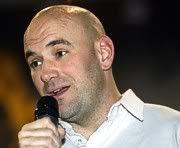Ultimate fighting kicks violent image

By Sonia Oxley
Ultimate fighting has shed its no-holds-barred image and reinvented itself as exciting and safe to become one of the fastest growing spectator sports in the United States.
Branded barbaric by critics in the 1990s because it had no rules, the Ultimate Fighting Championship (UFC) brand was bought out in 2001, and under president Dana White biting, eye-gouging, head-butting and strikes to the groin are among things banned.
The fighters, who wear just a pair of shorts and fingerless gloves, use mixed martial arts to overcome one another on an eight-sided mat in a cage.
Despite the efforts to distance the sport from the free-for-all image by introducing judges, weight classes and five-minute rounds, some critics denounce it as little more than a glorified brawl more suited to a bar on a Saturday night.
But the packed arenas and rising television viewing figures show that something about it is appealing to the public.
Tickets, often priced at more than $500, for arenas that hold several thousand people sell out within days and figures show millions watch it at home. US media reports say UFC generates more pay-per-view revenue than boxing in the United States.
Unsurprisingly, given the cost of tickets, the sport attracts celebrities. Actors George Clooney and Pamela Anderson are among the high-profile fans.
"Every time we're in Vegas, it's the who's who of Las Vegas, the who's who of Hollywood and then all our hardcore fans, the 18-34s," White told Reuters.
The big money is not just limited to watching the sport, with the top fighters earning millions of dollars per year.
"It's a very exciting sport," said British fighter Michael Bisping. "Sometimes it's blink-and-you-miss-it action. It's the purest form of combat that there is."
Fighters and organisers are still battling to improve the sport's image, which was tarnished in the early years when it was banned from several US states and taken off cable television under political pressure.
"People looking from the outside see it and think that it's violent and that these guys are violent brutes but that's not really the case at all," said White, who was in Britain to promote next month's first UFC fight in the country.
"Most of the guys who fight in the UFC are college-educated guys, they have families, they're normal good guys."
There is even a politician on the UFC's books -- Mirko Cro Cop is a member of the Croatian parliament and former policeman.
DISCIPLINED ATHLETES
Bisping said the fighters were not respected enough in terms of their athletic quality.
"A lot of people just think it's two thugs getting in a cage and fighting, which isn't the case," said Bisping, who worked as an upholsterer before winning the U.S. reality television show 'Ultimate Fighter' last year that landed him a UFC contract.
"It's highly disciplined athletes who train as hard as any other athletes in the world."
Experts attribute the sport's growing popularity partly to the 'Ultimate Fighter' television show, which was available on cable television rather than pay-per-view and pulled in audiences of up to 10 million.
People who had seen that show got interested and signed up for the pay-per-view UFC fights.
"After the first series of Ultimate Fighter, they at the time had their biggest ever pay-per-view audience ... double what they had before," said David West, who writes for several ultimate fighting publications.
The introduction of rules and referees has helped ensure injuries are kept to a minimum and the UFC says there have been no serious injuries or deaths from the sport, unlike from boxing, mostly because fighters get fewer blows to the head. "You get a few bumps and bruises here and there and that's about it," said Bisping.
(Source)






















No comments:
Post a Comment